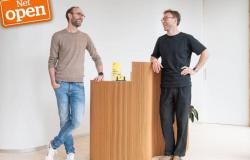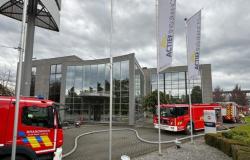The province of Flemish Brabant is investing 565,979.31 euros in 9 projects of Natuurpunt Beheer and the Regional Landscapes of Flemish Brabant. These projects strengthen biodiversity in Flemish Brabant.
“We invest in our nature,” says Bart Nevens, deputy for the environment. “In highly urbanized and densely populated Flemish Brabant, it is not easy to bring nature close to people again. That is why projects that strengthen biodiversity in our province receive our support.”
The province of Flemish Brabant invests in realizing a climate-proof and biodiverse landscape through subsidies for sustainable biodiversity projects. These projects provide added value for the Provincial Priority Species/Nurturing Neighbors and their habitats and strengthen the green-blue network within Flemish Brabant.
The following projects received support:
‘Bredeweg, green support of the Duisburg plateau’ from Regional Landscape Dijleland in Bertem, Huldenberg and Tervuren
‘Residential care centers make the link with the landscape’ of Regional Landscape Dijleland in Huldenberg
‘Insect islands’ of Regional Landscape North Hageland in Aarschot, Begijnendijk, Keerbergen, Scherpenheuvel-Zichem and Tremelo
‘Blue Network Grote Molenbeek’ of Regional Landscape Brabantse Kouters in Asse, Opwijk, Londerzeel, Merchtem and Meise
‘Educational food forests Pajottenland and Zennevallei’ by Regional Landscape Pajottenland & Zennevallei in Beersel and Gooik
‘More birdwatching from yellowhammer and lapwing’ from Regional Landscape Pajottenland & Zennevallei in Sint-Pieters-Leeuw, Lennik, Gooik, Pepingen, Herne, Bever and Galmaarden
‘Plan Pine Marten in Action 3’ by Regional Landscape Pajottenland & Zenne Valley in Halle
‘Nature restoration on the Wijngaardberg – part 1’ by Natuurpunt Beheer in Rotselaar
‘A tailor-made landscape: curlews in Flemish Brabant’ by Natuurpunt Beheer in Geetbets
More information about the projects:
Bredeweg, green support of the Duisburg plateau (amount: 75,000 euros, term: 2024-2026) of Regional Landscape Dijleland
The aim of the project is to develop the Bredeweg into an important green support for the fine-meshed network of small landscape elements on the Duisburg plateau in Bertem and Huldenberg. By developing small landscape elements on the edges of this road, the road fits better into its environment, Natura 2000 areas are better ecologically connected and further efforts are made to promote biodiversity, with special attention to field birds. The plateau is therefore an important management area for field bird species, such as yellowhammer, gray bunting, lapwing, partridge, quail, skylark, short-eared owl, hen harrier and Montagu’s harrier.
In addition, a section of the F29 bicycle highway in Bertem, Huldenberg and Tervuren will be provided with a green ribbon. In this way, adjacent ecologically valuable forest fragments, such as the Weebergbos and the Tersaertbos, Natura2000 habitats and small landscape elements are connected. In addition, valuable sunken roads are further protected from erosion and nutrient leaching from the fields.
Collaboration between Regional Landscape Dijleland, Strategic project Walden, Strategic project Horizon+, municipality of Bertem, municipality of Huldenberg, municipality of Tervuren, De Werkvennootschap, province of Flemish Brabant, ANB, AOE, land owners and users, WBE, VLM and VHM.
’Residential care centers make the link with the landscape’ (amount: 31,745.96 euros, term: 2024-2027) by Regional Landscape Dijleland
In this project, Regional Landscape Dijleland will design several plots of fallow land and lawn in a nature-friendly manner and strengthen the connection with the landscape. The plots belong to WZC Ter Meeren and WZC Keyhof in Huldenberg. The objectives are, on the one hand, to better embed the WZCs in the landscape with attention to biodiversity and climate resilience, but also to utilize their positive influence on well-being.
Concrete actions:
WZC Ter Meeren: planting wide wooded edges and deciduous trees, constructing wadis, setting up extensive management of flower-rich grassland, sowing with an adapted flower mixture and installing a bee hotel
WZC Keyhof: planting blossom hedges, deciduous trees, shrub groups and insect borders, flower bulbs, establishing extensive management of flowery grassland, creating bee-friendly flower borders and shrubs, laying out small picking orchards and meadows, pergolas covered with climbing plants over existing paths and installing an insect hotel
In Flanders, the number of pastures for hobby animals is increasing. Former hay fields are now intensively grazed and trodden and therefore lose much of their natural value. Transforming these meadows into a ‘paddock paradise’. Such a ‘paddock paradise’ is a walking path around meadows where the horses can continue to run indefinitely. This spares part of the meadow from intensive grazing and foot traffic and allows biodiversity to increase again.
The project is also being opened up to other opportunities in meadows with hobby animals other than horses. For each meadow, it is then examined how local biodiversity can be optimally supported. This can range from creating a running track to additional plantings and adapted grazing management.
Regional Landscape North Hageland will use this concept to create insect islands in meadows in Aarschot, Begijnendijk, Keerbergen, Scherpenheuvel-Zichem and Tremelo, where the brown fire butterfly, but also other species, can find a home.
Cooperation between Regional Landscape North Hageland, Natuurpunt Studie and private owners.
’Blue Network Grote Molenbeek’ of Regional Landscape Brabantse Kouters (amount: 74,962.50 euros, term: 2024-2027)
The Grote Molenbeek and the (Kleine) Molenbeek meander like green-blue ribbons through the agricultural landscape in Asse, Opwijk, Londerzeel, Merchtem and Meise. The catchment area is known to be very prone to flooding. But the wet character and the relatively intact valley landscape also offer opportunities to strengthen the natural values here.
Through this project, Regional Landscape Brabantse Kouters will strengthen the blue-green network in the valley through nature development projects, such as digging new pools, restoring existing pools, remeandering canals, nature-oriented restoration of slopes and banks and constructing small dams. and dams to better retain rainwater in the valley.
Cooperation between Regional Landscape Brabantse Kouters, Regional department Natuurpunt Noord-West-Brabant, the local departments of Natuurpunt Asse, Londerzeel, Meise, Merchtem and Opwijk, various owners such as private individuals, the municipality of Merchtem, ANB and Aquafin.
’Educational food forests Pajottenland and Zennevallei’ from Regional Landscape Pajottenland & Zennevallei (amount: 36,198.85 euros, term: 2024-2026)
The Pajottenland & Zennevallei Regional Landscape will develop two educational food forests, one in the Paddenbroek Rural Center in Gooik and the BosAardBlij food forest in Beersel.
Collaborationg between Regional Landscape Pajottenland & Zennevallei, municipality of Gooik, Rural Center Paddenbroek PEVA, municipality of Beersel, volunteers Food Forest BosAardBlij, Natuurpunt Studie, Velt vzw, Pluktuinen Pajottenland, agricultural working group Rural Center Paddenbroek, Gooikse schools, Beerselse schools, local Natuurpunt departments, PajottenMotten (insect working group SW Brabant) and other working groups.
Field birds are strongly connected to the Flemish agricultural landscape but are under strong pressure from increases in scale, more intensive land use, fragmentation and the disappearance of small landscape elements.
Because the Pajottenland is an important region for field birds, Regional Landscape Pajottenland & Zennevallei is starting a project that focuses on measures that meet the three basic needs of field birds: food, cover, breeding and nesting.
The focus is on lapwing and yellowhammer. For the lapwing, the focus is on nest protection within the most important breeding clusters. In addition, strong efforts are being made to restore the habitat of both species through concrete measures on the ground.
Collaboration between Regional Landscape Pajottenland & Zennevallei, farmers, volunteers, business planner VLM, Boerennatuur Vlaanderen, department of agriculture, involved municipalities, working group on meadow and field birds, bird protection Flanders, bird working group, wildlife management units, ANB, Natuurpunt and INBO.
‘Plan Pine Marten in Action 3′ of Regional Landscape Pajottenland & Zennevallei (amount: 75,000 euros, term: 2024-2026)
This project is part of Plan Pine Marten, a collaboration for more nature around the Hallerbos and other forests south of Halle. Since 2006, work has been done on a strengthened habitat for the pine marten by connecting fragmented nature through forest expansion.
Work is also being done on forest expansion, biotope restoration and expansion of small landscape elements around the Berendries and Maasdalbos nature reserves of Natuurpunt in Halle.
Collaboration between Regional Landscape Pajottenland & Zennevallei, Natuurpunt Halle, Natuurpunt Beheer and the city of Halle.
‘Nature restoration on the Wijngaardberg-part 1’ by Natuurpunt Beheer (amount: 61,512 euros, term: 2024-2027)
In recent years, several plots have been purchased to expand the nature reserve on the Wijngaardberg.
Through the first phase of this project, four plots on the southern flank will be cleared of farms, constructions, rubbish, fencing and exotic vegetation will be removed. This should create more space for native species of forest plants and animals, such as wild rush, valley weed, lily of the valley, common Solomon’s seal, wild honeysuckle, black woodpecker and honey buzzard. Once the properties are more contiguous, a mosaic landscape will be created with heathland, coppice and small shrubs, which will enhance the habitat of nurturing neighbors such as yellowhammer and nightjar and native species such as true goldenrod, pill sedge, dog violet, creeping broom, slow worm and field cricket.
Collaboration between Natuurpunt Beheer, Natuurpunt Rotselaar and the municipality of Rotselaar.
‘A tailor-made landscape: curlews in Flemish Brabant’ by Natuurpunt Beheer (amount: 63,997.50 euros, term: 2024-2027)
The curlew population in Flanders is declining sharply due to a loss of the quality and quantity of their habitat. Curlews like open landscapes with species-rich, moist grasslands where sufficient food is available.
The aim of this project is to develop design and management measures that meet the needs of curlews in their habitat, with a focus on their core area in the Gete and Velpe valley.
More information about the subsidy regulations for biodiversity projects: https://www.vlaamsbrabant.be/nl/premies-en-subsidies/duurzaam-biodiversiteitsprojecten
Back






